 | Featured City Birds
Wild City Birds of San Francisco and Beyond |
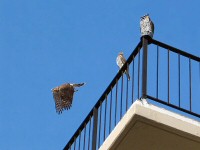 |
In a land of representative government, we can only expect that lawmakers pass laws which reflect the will of the people. San Francisco is known for its many anti-bird laws which, supposedly, reflect how the people of the City feel about wild birds.
Fastened atop a number of buildings throughout City Birds Country, the Heart of San Francisco, are found grotesque looking fake owls with (possibly lead based) painted feathers, and placed with the purpose of frightening off all manner of birds -- More.
|
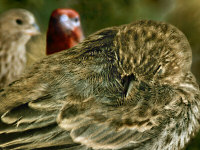 |
This is a close-up of a young House Finch napping while proud parents stand guard. Growing House Finches, like humans, need good food and lots of sleep in order to grow strong.
The gradual elimination of historic old-growth trees and other natural habitat in City Birds Country, the Heart of San Francisco, makes it essential that people provide food for them (and other small birds) if these beautiful wild songbirds are to have any chance of survival here. More.
|
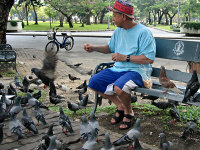 |
Bangkok, Thailand is a city of around 15 million people. A thriving bird population also lives there. People can feed the birds and vendors sell bags of bird food. These city birds also eat food which might otherwise go to rodents. Pigeons serve as food for raptors, human enjoyment and as pest controllers. Feeding birds is illegal in San Francisco, a city of 800 thousand people. People who would feed them must do so with one eye on the birds and one eye watching for the police.
This photo was first published April 1, 2007 by City Birds. |
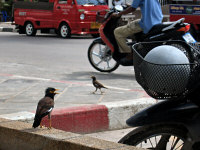 |
In addition to Pigeons in the large cities such as Bangkok, throughout Thailand and neighboring countries is found a wide variety of birds -- some similar to those found in American cities such as Pigeons and Crows, while others are quite unique in appearance. This pair of Mynas, which are of the Starling family, in the thick of things shows no fear of the human life going on around them.
This photo was first published April 1, 2007 by City Birds. |
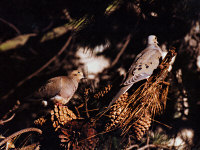 |
City Birds Country, the Heart of San Francisco has a rather small Mourning Dove population. Unlike Rock Doves (Pigeons), they are not see on sidewalks foraging for food. They are a bit shy and prefer inner courtyards in which to forage for food. Their numbers are dwindling as courtyards are swallowed up to provide space for larger buildings in which to support our burgeoning human population. This pair is seen basking in the warm, late afternoon sunshine.
This photo was first published October 23, 2006 by City Birds. |
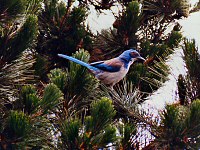 |
The colorful Scrub Jays used to forage for food regularly on this old growth pine, brightening up the dreariest of our dark, foggy days. However, we have not spotted a Scrub Jay in City Birds Country, the Heart of San Francisco since 1998 -- perhaps due to over-population by humans and the resulting loss of food sources.
This photo was first published October 23, 2006 by City Birds. |
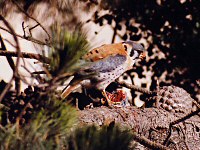 |
The American Kestrel, seen here dining on a House Finch, is America's smallest falcon -- about the size of a Mourning Dove. A migratory bird, it was a regular visitor to this tree during the Spring and Autumn. Although the beautiful American Kestrel is a personable bird, they proved vexing to us due to our efforts to sustain the House Finch population in these parts. Not for lack of food, the Kestrel suddenly disappeared from these parts and we have not spotted one since 2000.
This photo was published October 23, 2006 by City Birds. |
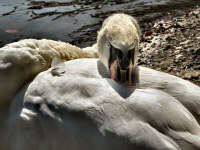 |
The Mute Swan is a beautiful bird which has inspired art and music. First introduced to the United States in the 1800s, its habitat is residential ponds and lakes such as the pond at the Palace of Fine Arts in San Francisco, where we photographed the swans. Although the Mute Swan has a peaceful and gentle personality, when getting close to them it is important to be very respectful. They are a powerful bird and a neck blow can break the arm of a full-grown man.
This photo was first published October 23, 2006 by City Birds. |
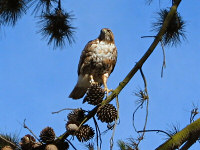 |
The raptor population in San Francisco has been in general decline over the past years. One reason is the loss of natural habitat. Beautiful Red-tailed Hawks used to spend time hanging out on a very large, old-growth pine tree in the middle of a courtyard surrounded by apartment buildings. Other birds fed off the tree as well. The birds are gone now; the healthy tree having been cut down. Enjoy our two videos featuring this same Red-tailed Hawk.
This set was first published July 27, 2006 by City Birds. |
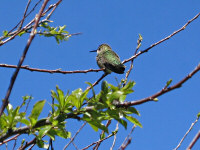 |
Surprisingly, considering the strong Westerly winds so common in San Francisco, there is a substantial population of Hummingbirds living in City Birds Country, the Heart of San Francisco. The picture of this female Anna's Hummingbird relaxing in the sunshine was taken during a fine Spring 2006 morning at the Public Gardens located in the midst of Fort Mason. Even the windy, Western sides of Nob Hill and Russian Hill support a modest population of Hummingbirds. This photo was first published by City Birds June 6, 2006. |
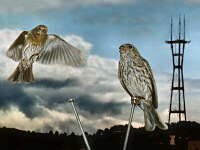 |
Feeding the City Birds is rewarding in many ways. Without handouts from humans, the presence of birds, such as these beautiful House Finches, would be rare. Natural habitat for birds is very limited in San Francisco. They depend on humans for their survival. The finches fill the streets with their beautiful songs from early Spring through mid-Summer. Well fed, they have time to play. Toys, such as old rabbit ears, will be put to good use by them. Here we see a female, having landed, filled with pride; while to the left, we see breath-stopping determination on the face of the gold male finch coming in for a landing. This illustration was published June 6, 2006 by City Birds. |
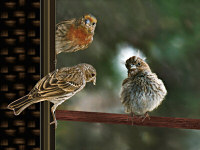 |
The brightly colored male House Finch has a whole sunflower seed in his mouth. He will use his tongue to position the seed so it conforms to the shape of his beaks. Then, using his tongue to rotate the seed, the sharp sides of his mandibles will peel off the waxy covering which protects the seed. The female House Finch (lower left) is further along in removing the covering from the seed in her mouth. Notice the ribbon of chaff hanging from her beaks. Once the seeds are peeled, the finches will chew and swallow the seed. More. |
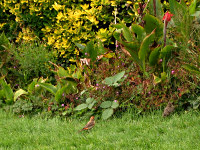 |
A pair of House Finches at the Golden Gate Park Gardens, San Francisco, is in search of something to eat; but bird food is very scarce in the Park. Birds are scarce too. The gold male is trying to get his mate to enter the dense "forest" before her in search of food; but she turns and says: "I'M not going in THERE!" With the reduction of natural habitat, birds of all size depend upon humans for survival. This photo was first published December 9, 2005 by City Birds. |
In addition to San Francisco scenes and events, the many San Francisco Galleries also have photos of many birds of City Birds Country, the Heart of the City. A bird search of the City Birds Website will lead you to even more city birds.
|
Featured Birds Pages: 1
2 3 4
|
| © City Birds Multimedia. All Rights Reserved. |
|